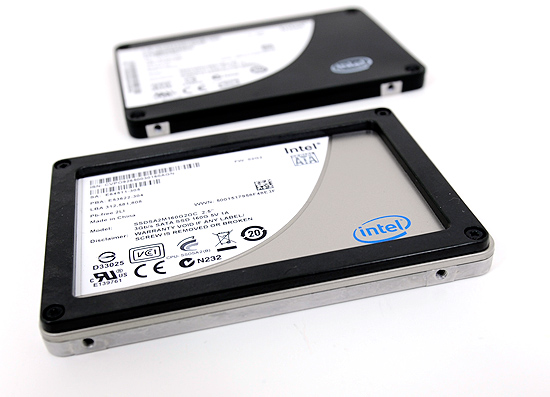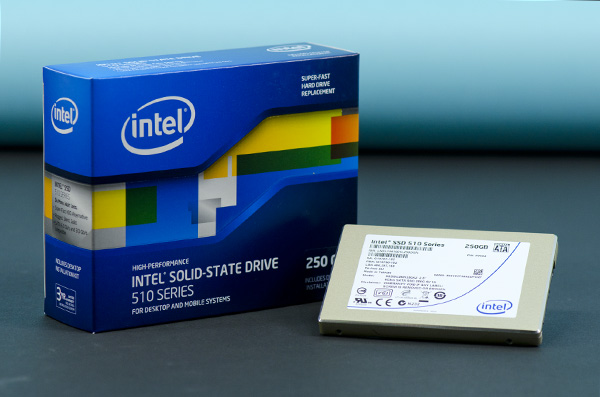The Intel SSD 510 Review
by Anand Lal Shimpi on March 2, 2011 1:23 AM EST- Posted in
- IT Computing
- Storage
- SSDs
- Intel
- Intel SSD 510
The X25-M was a tremendous first attempt by Intel to get into the SSD market. In our review of the SSD I wrote that Intel just Conroe’d the SSD market, and if it weren’t for the pesky 80MB/s sequential write speed limitation the X25-M would’ve been given the title: World’s Fastest Drive.

Its successor, the X25-M G2, was a mild update that brought prices down through the use of 34nm NAND. Remember that Intel is also 49% owner of the IMFT joint venture and as a result can be quite competitive on NAND pricing (and quite early to adopt new NAND technologies).

Intel’s goal all along was to drive down the cost of SSDs. Looking at the history of MSRPs with the X25-M (not to mention the M, which stood for Mainstream in the product name) this shouldn’t come as a surprise:
| Intel X25-M Pricing History | |||||
| 2008 | 2009 | ||||
| 40GB | - | $125 | |||
| 80GB | $595 | $225 | |||
| 160GB | $1000+ | $440 | |||
The third generation X25-M was to drive down costs even further, this time thanks to Intel’s 25nm NAND. You’d be able to get twice the capacity at the same price point as the X25-M G2. The value drive would be an 80GB offering, the mainstream drive would be 160GB and the high end drive would be 320GB.
The drive would offer higher performance. The controller was to be completely redesigned, with the “oversight” that limited sequential write speed to only 100MB/s corrected entirely. In addition, the third generation Intel SSD would add full disk encryption - making it even better suited for enterprise customers. Going after the enterprise market was Intel’s plan to really make money on SSDs in the long run. Instead of just selling corporations a CPU, chipset and wireless controller in a notebook, there would be an SSD on top of all of that. Perhaps eventually even have some security software courtesy of McAfee.
The third generation X25-M was originally due out in the middle of 2010. As is usually the case with schedules, the “G3” slipped. The middle of the year became the end of the year and the end of the year became Q1 2011.
To make matters worse, the specifications Intel was talking about for its third generation drive/controller weren’t all that competitive. We published the details last year knowing that the competition would do better. Intel’s redesigned controller was late and underperforming. Internally, Intel knew it had a problem.
Intel aimed for the majority of the market with the X25-M, it had set its sights on lowering cost, but it left the high performance enthusiast market entirely uncared for. A void that SandForce filled quite nicely with its unique brand of controllers.
With a hole in the roadmap and an unwillingness to cede complete control of the high end market to SandForce, Intel did the unthinkable: developed a new SSD based on a competing controller technology.











128 Comments
View All Comments
aarste - Wednesday, March 2, 2011 - link
Those graphs on the TRIM test look nothing remotely close to ATTO, which I use. I checked HDTach as well and it wasn't that, but close.What app was it?
mino - Wednesday, March 2, 2011 - link
Please, be so king and include a fast HDD (say a WD Velociraptor) in EVERY SSD benchmark.While most readers here understand the difference between SSD and HDD, including a single fast HDD would make the article useful also as a reference/datapoint when talking to not-so-techy people.
strikeback03 - Thursday, March 3, 2011 - link
Then people would complain because the numbers are so small as to be unreadablenerex - Wednesday, March 2, 2011 - link
Maybe I missed it, but i didn't see any discussion of the power usage of the new drives- according the intel press releases, the new drives use 380mW/100mW active/idle and the G2 drives only use 150mW/75mW active/idle.This means the new drives would actually be worse on laptop battery life, correct?
DigitlDrug - Saturday, March 5, 2011 - link
Hi Anand,+1
Power consumption figures would be great for us laptop users!
I find it interesting that a number of these drives report consumption of up to 3watts and others are in the mw range when browsing the Egg.
Some clarity on power consumption would be a great addition.
As always, great review!
ClagMaster - Wednesday, March 2, 2011 - link
The Intel SSD 510 is not a bad drive but it cost more than a Vertex 2 or 3.The Intel Toolbox, and extensive compatablity and reliability testing are major pluses.
The SSD is still an extravagance for desktops though I can see its a no-brainer for laptops because of power conservation. Unless the cost per gigabyte is less than $0.80/gigabyte, the performance gain does not offset the mechanical harddrive.
neotiger - Wednesday, March 2, 2011 - link
I.e., an epic FAIL product priced at a premium to competing products that are far superior.What misguided priorities from Intel. People shell out the big bucks for SSD's for their RANDOM IO performance, NOT sequential IO. So the geniuses at Intel decided to release a "next gen" product that actually has WORSE performance than the last gen product. Really?
I'm speechless. The really sad part about this fiasco is that most people will still buy this piece of crap over far superior competing products just because it's Intel.
Just like NetBurst all over again.
strikeback03 - Thursday, March 3, 2011 - link
Did you actually look at the real-world results? the 510 is almost twice as fast as the G2 160GB in some tests.poohbear - Wednesday, March 2, 2011 - link
nice review, but you're talking & comparing the Vertex 3 and this new drive, but where's the vertex 3 on the market? its not even released, its months away from release if im not mistaken? the C400 will be released before it, so what's the point of comparing tech today with tech months away from release (and in the SSD world months is a very long time!)sor - Wednesday, March 2, 2011 - link
FWIW, we've deployed literally hundreds of X25-E drives, and our failure rate is well over 1%, closer to 2%. Usually they drop link, try to renegotiate at 1.5Gbps, and fail, so it's more likely the controller than a wear-out issue.